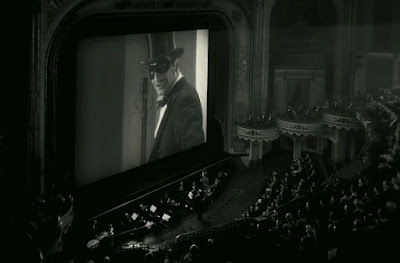 Portrait of the Film as a Young Medium
Portrait of the Film as a Young Mediumor
Silents is Golden
First off...GREAT sound-design.
(tap, tap, tap...is this mic' on?)
It's easy to be positively giddy over the success that The Artist has enjoyed (ultimately winning the year's best Picture Oscar). I've enjoyed Michel Hazanavicius' previous pairings with Jean Dujardin—the spy-spoof OSS-117 films—even if they were a little uneven, they managed to nail the ambiance of the films they were parodying, while also chortling over their excesses, even while embracing them.
And Dujardin is a terrific performer, light on his feet and hitting his comedy points with deft left jabs. In the "OSS" films, it was pretty obvious that he was a superb cross-over entertainer, believable when playing it straight (if ever), but also knowing just how far to push things to trip it into comedy. Unlike Peter Sellers, whose agents always seemed to be harboring deep-set inferiority complexes underneath their pompous egotism, Dujardin was always blissfully clueless, truly believing that he was terrific, and that the strings of pratfalls, misfires and collateral damage were just temporary set-backs, no matter how regularly they occurred, followed by a laugh that was too loud and went on far too long.
The Artist has no problems of pace, or of sequences that fall flat. It takes its strengths from the medium it cherishes—the silent films on the cusp of sound, when the visual art of story-telling was at its peak and was somewhat quashed to accommodate the large pieces of equipment that could squeak and rumble and ruin a fluid camera movement, and when expression was King. The world of film was silent and focused on image—I was struck in a sequence that showed a high angle of a motion-picture theater audience watching a film being projected with symphonic accompaniment, that the eye always wandered to what was on screen—it tells its story with the directness of vision of that particular era (okay, some close-ups belie the time and the film dispenses with fog-filters and other tricks employed then) and the clean image of glamour, even to the simplicity of a cold-water flat of an apartment.
Faces are carefully chosen for contrast and specificity of character, rather than overall performance, and one can only imagine the voices that accompany the expressions—appropriately, dialog cards are used, but sparingly—nothing aural spoils the picture contained within the frame, widening it or presenting the intrusion of a world outside of it, a point that is made quite literally at one point in one very clever sequence. One is clued in early on, when movie star George Valentin (Dujardin) stands behind the movie screen as his film ends and awaits acknowledgment from the crowd. Haznavacius holds on his image as he waits—there is only silence—until he raises his fist in triumph at the applause we cannot hear, and which is verified only by the enthusiasm of the crowd in the next shot. The rules are set—we have to trust in what we see, not in what we expect to hear. This is not verisimilitude—the illusion of reality imposed by sound and image—this is a heightened and false world of industrialized artifice, concentrated and crystallized in glamorous black and white fiction, flaws be damned.
 |
| "...the eye always wandered to what was on screen" |
But, it's more than that. Haznavacius isn't satisfied (as Mel Brooks was in his own Silent Movie of 1976) with just making a film without sound. He takes pains to evoke the era in which they were made, choosing the Los Angeles locations of the film extraordinarily carefully, to emphasize the arid spaces and chiaroscuro-deco architecture of the time (one nice sequence of a chance meeting on a studio staircase between Valentin—on his way down—and plucky starlet Peppy Miller—Bérénice Bejo, on her way up—is filmed in the beloved Bradbury Building, as if Fritz Lang or King Vidor had filmed it—straight on—as if to emphasize the ant-like activity of the personnel. And there is a visual grace to the story-telling that evokes the poetry that silent films were capable of in getting their point across without words.
 |
| "...when the visual art of story-telling was at its peak" |



No comments:
Post a Comment